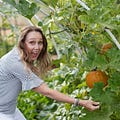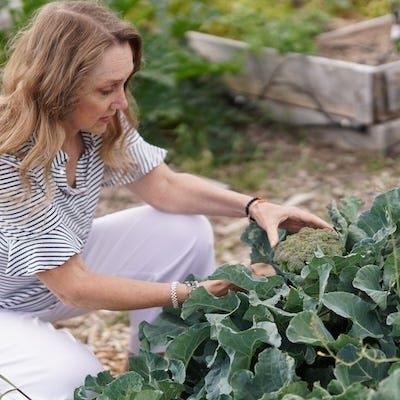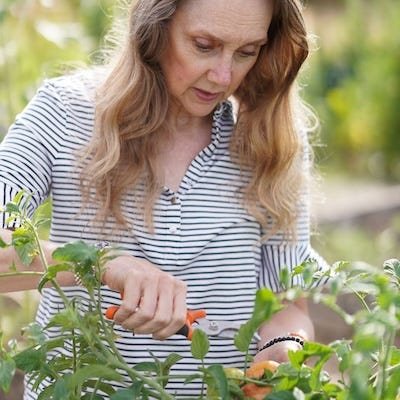Who Knew? Even your garden needs a plant-based lifestyle
The ewww in researching what to put in my garden
I love my garden this year!
We’ve been in a community garden for the past two years. At the start of this season, we were offered a chance for a full plot, moving from a 10x20 half-plot to a full 20x20 size. We jumped at the chance, and have thoroughly enjoyed our third season in an extended plot.
At the start of the summer, we met the previous owner. She and three friends have managed two plots side by side for years, but after two of the four moved away, they gave up one plot - which is now ours.
She’s studying to be a master gardener, and I’ve enjoyed learning from her over the summer months. As we worked outside getting things ready in the spring, she gave me tips and advice.
“This area is low in nitrogen. We add blood meal consistently to give the dirt the energy it needs.”
When I got home, I researched blood meal. Wikipedia informed me it’s a slaughterhouse by-product from cattle and hogs.
Um, no.
Soil is NOT soil - An Education
Dirt is dirt, right? It’s easy to get caught up in that when you’re not a farmer. Even with the plants you plant at home, fill a pot with soil and watch your plants grow.
I get that - I thought that way for much of my life. This is something you have to open up to over time.
Instead of just being a vessel for growing, soil is a complex and dynamic ecosystem composed of minerals, organic matter, water, air, and countless microorganisms. What that means for us as home gardeners is soil is much more than just dirt; it is the foundation of a healthy garden.
Good soil supports plant growth by providing essential nutrients, maintaining moisture, and offering a stable structure for roots to anchor. Healthy soil also fosters beneficial microbial activity, which can enhance nutrient uptake and protect plants from diseases.
Ever wondered why some plants grow and some plants die? It starts with the soil.
Farmers get that. But we’ve gotten lost this past century with what that truly looks like. We think to grow more requires more chemicals. So we’ve dumped chemicals, moved into monocropping, and tried to override what’s really happening in the soil.
I keep saying this to myself: Healthy soil provides plants with the necessary nutrients they need to thrive. It also supports beneficial organisms that can improve plant health and productivity.
That means well-maintained soil reduces the need for chemical fertilizers and pesticides, leading to a more sustainable gardening practice. This, in turn, helps protect the environment by preventing soil degradation and water contamination.
Healthy soil promotes biodiversity, not just in terms of plants but also in the microbial and insect life it supports. This biodiversity can lead to a more resilient garden that can better withstand pests and diseases.
It really is full circle. This is an over-simplistic look at soil and food growing, but I state this to make a point. Even your small home garden won’t produce the best fruits and veggies possible without a little work.
And I believe that starts with what you put into the ground.
What Does Soil Do to the Foods I Grow?
It’s easy to think about what you’re planting. I chose broccoli and eggplant and squash and tomatoes. I had a 20x20’ plot to work with, and I placed them somewhat willy-nilly throughout the plot.
This is a work in progress. I change my approach every year as I learn.
This year, I’m learning a lot more about soil quality.
Soil has a direct impact on the quality and nutritional value of the foods you grow.
That means the nutrients present in the soil directly affect the nutrient content of the plants. Healthy soil enriched with organic matter and a balance of minerals ensures that the fruits and vegetables grown are nutrient-dense. Easy to understand, right?
Soil health can also influence the flavor, texture, and overall quality of produce. Plants grown in nutrient-rich, healthy soil often have more vibrant flavors and better textures compared to those grown in poor soil conditions.
The reverse is also true. Poor soil quality can lead to the uptake of toxins or heavy metals, which can end up in the food you consume. I believe healthy soil, managed with organic practices, reduces this risk, ensuring cleaner and safer produce.
Now let’s go back to blood meal.
I’m plant-based. I believe in high-quality plant-based foods.
I have very heated opinions on the concept of “meat.”
Blood meal is the by-product of the slaughterhouse. Which means it’s a product from chemicalized, traumatized animals.
When I think of what I want to feed my veggies, my garden’s soil, and ultimately my body isn’t that. Instead, I want them to have positive energy, quality nutrients, and love and care as they grow from seed to veggie.
Blood meal is the norm. It’s widely accepted.
I don’t accept the norm.
So once again, I have to go looking.
And I’ve been using two products on my soil all summer long.
I start with Vegan Mix, an all-purpose fertilizer that I pour into the hole before I place my plants in and cover them up. An extra boost to get them started.
Then I’ve been using Maxicrop, a soluble seaweed powder designed for improved plant health and enhanced root development. Once a week, I mix up a batch and water my plants with it.
I found these two products after “vegan” searching, and found many home gardeners who swear by these two products. After one season, I will be using both of these products again next year.
I ran into my plot neighbor a few days ago, the one who is working on her master gardener certificate. Her words: “Whatever you did to your garden, it looks great! I’ve been impressed watching it grow.”
Plant-based - It’s a lifestyle thing
Here’s what I believe.
Everything has energy. What we put out is what we receive.
Earth is our mother and we are blessed to live in her house.
That means caring for it. With everything we do. Every day. No matter what.
When you awaken to moving plant-based in one area, your senses are jolted in another area. It makes sense in one way, so you have no choice but to move in another direction.
I couldn’t put blood meal in my garden. It just didn’t make sense. So I went looking for options.
They are there. You just have to look for them.
And there are great options. Always will be. Because others have asked the same questions, and developed solutions.
Even in your garden.
I encourage you to change your questions and look for plant-based answers. You might just feel something new.
p.s. Did you like this message? It would mean a lot to me if you’d press the ❤️ below if you liked it, left a comment 💬, or shared it with a friend. I’m trying to grow this publication, and I depend on people like you to do so!
And if you’re new here, Welcome! 💐 I’d love to start sharing my message with you if you’re interested in all things plant-powered, proaging, or finding kitchen joy. Subscribe … and then explore my entire archive! Glad to share with you! 🙋🏼♀️








